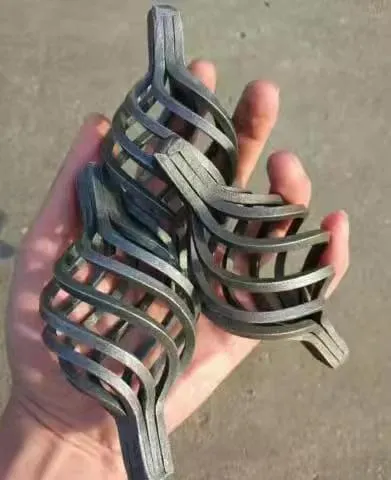Elegant Cast Iron Gate Decorations for Enhanced Curb Appeal and Design Aesthetics
The Art and Craftsmanship of Cast Iron Gate Ornaments
When it comes to enhancing the beauty and security of a property, few elements can rival the elegance and durability of cast iron gate ornaments. These decorative features have been used for centuries to elevate the aesthetic appeal of gates while also serving practical functions. Their rich history, intricate designs, and resilience make them a popular choice for both residential and commercial properties.
Historical Significance
The use of cast iron in gate design dates back to the 18th century, coinciding with the industrial revolution. This era marked a significant advancement in metallurgy and manufacturing techniques. Craftsmen began to explore the aesthetic potential of cast iron, which allowed for more intricate and durable designs than previously possible with wrought iron or wood. As a result, elaborate cast iron gates adorned the entrances of grand estates, parks, and urban settings across Europe and later the Americas.
These ornamental gates not only served as barriers but also as statements of wealth and social status. The introduction of decorative motifs, such as scrolls, floral patterns, and geometric shapes, began to transform the mere function of gates into expressions of artistry. Cast iron became a canvas for creativity, showcasing the skills of artisans who poured their expertise into every piece.
Design Elements and Styles
Cast iron gate ornaments come in various forms, ranging from intricate scrollwork to bold geometric patterns. A popular design element in Victorian-era gates is the use of floral motifs. Roses, vines, and leaves intertwine to create a natural aesthetic, reflecting the era's admiration for nature. Gothic designs, characterized by pointed arches and intricate tracery, can also be found in cast iron gates, adding a dramatic flair to any entrance.
cast iron gate ornaments

Another fascinating aspect of cast iron gate ornaments is their versatility. They can be customized to suit different architectural styles, from classical to modern. Homeowners can choose from a variety of finishes, including matte, glossy, or even painted options, to complement the overall look of their property. This adaptability makes cast iron ornaments suitable for both contemporary homes and historic buildings.
Durability and Maintenance
One of the primary advantages of cast iron gate ornaments is their remarkable durability. Cast iron is known for its strength and resistance to weather elements, making it an excellent choice for outdoor applications. Unlike wood, which can rot, or aluminum, which can bend, cast iron maintains its structural integrity over time. This means that cast iron gate ornaments can withstand harsh weather conditions, from scorching sun to heavy rain and snow.
However, while cast iron is incredibly durable, it is not entirely maintenance-free. Regular inspection and maintenance are essential to prevent rust formation. Applying a protective coat of paint or sealant every few years can significantly extend the life of the ornaments, preserving their beauty and strength.
Conclusion
In conclusion, cast iron gate ornaments are not only functional elements that enhance security but also exquisite pieces of art that add charm and character to any entrance. Their historical significance, diverse design options, and unparalleled durability make them a wise investment for property owners looking to make a lasting impression. Whether adorning a grand estate or a cozy home, cast iron gate ornaments continue to captivate with their timeless beauty and craftsmanship. Embracing this form of artistry is an ode to tradition, showcasing a profound appreciation for design and durability that transcends generations. As the world continues to evolve, the allure of these ornamental features remains steadfast, reminding us of the rich heritage and craftsmanship that define our architectural landscapes.
-
Wrought Iron Components: Timeless Elegance and Structural StrengthNewsJul.28,2025
-
Window Hardware Essentials: Rollers, Handles, and Locking SolutionsNewsJul.28,2025
-
Small Agricultural Processing Machines: Corn Threshers, Cassava Chippers, Grain Peelers & Chaff CuttersNewsJul.28,2025
-
Sliding Rollers: Smooth, Silent, and Built to LastNewsJul.28,2025
-
Cast Iron Stoves: Timeless Heating with Modern EfficiencyNewsJul.28,2025
-
Cast Iron Pipe and Fitting: Durable, Fire-Resistant Solutions for Plumbing and DrainageNewsJul.28,2025
-
 Wrought Iron Components: Timeless Elegance and Structural StrengthJul-28-2025Wrought Iron Components: Timeless Elegance and Structural Strength
Wrought Iron Components: Timeless Elegance and Structural StrengthJul-28-2025Wrought Iron Components: Timeless Elegance and Structural Strength -
 Window Hardware Essentials: Rollers, Handles, and Locking SolutionsJul-28-2025Window Hardware Essentials: Rollers, Handles, and Locking Solutions
Window Hardware Essentials: Rollers, Handles, and Locking SolutionsJul-28-2025Window Hardware Essentials: Rollers, Handles, and Locking Solutions -
 Small Agricultural Processing Machines: Corn Threshers, Cassava Chippers, Grain Peelers & Chaff CuttersJul-28-2025Small Agricultural Processing Machines: Corn Threshers, Cassava Chippers, Grain Peelers & Chaff Cutters
Small Agricultural Processing Machines: Corn Threshers, Cassava Chippers, Grain Peelers & Chaff CuttersJul-28-2025Small Agricultural Processing Machines: Corn Threshers, Cassava Chippers, Grain Peelers & Chaff Cutters












